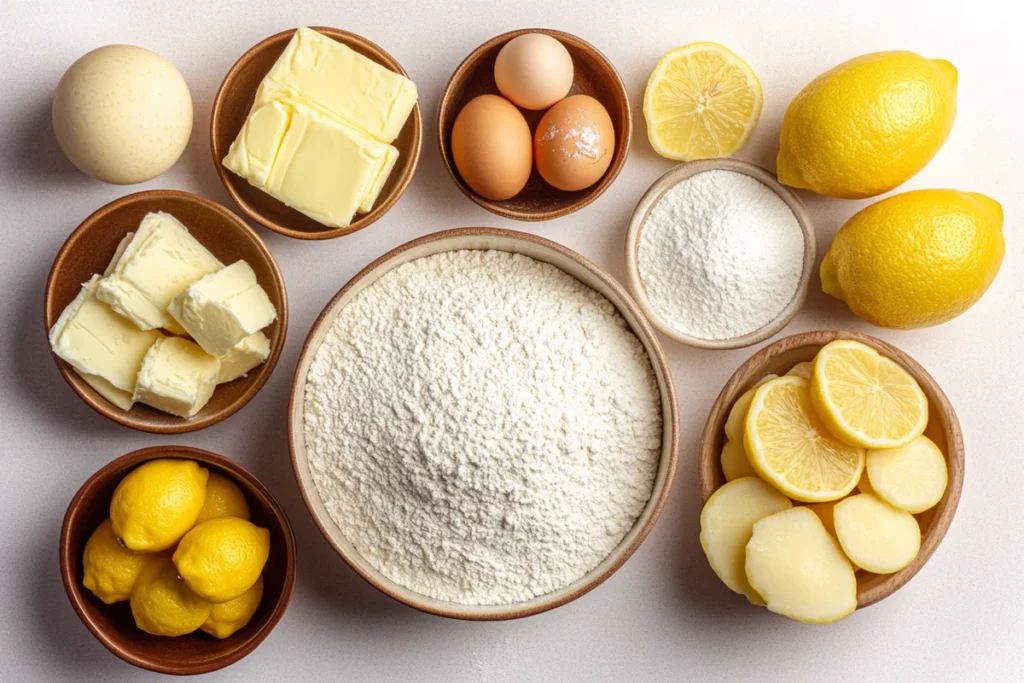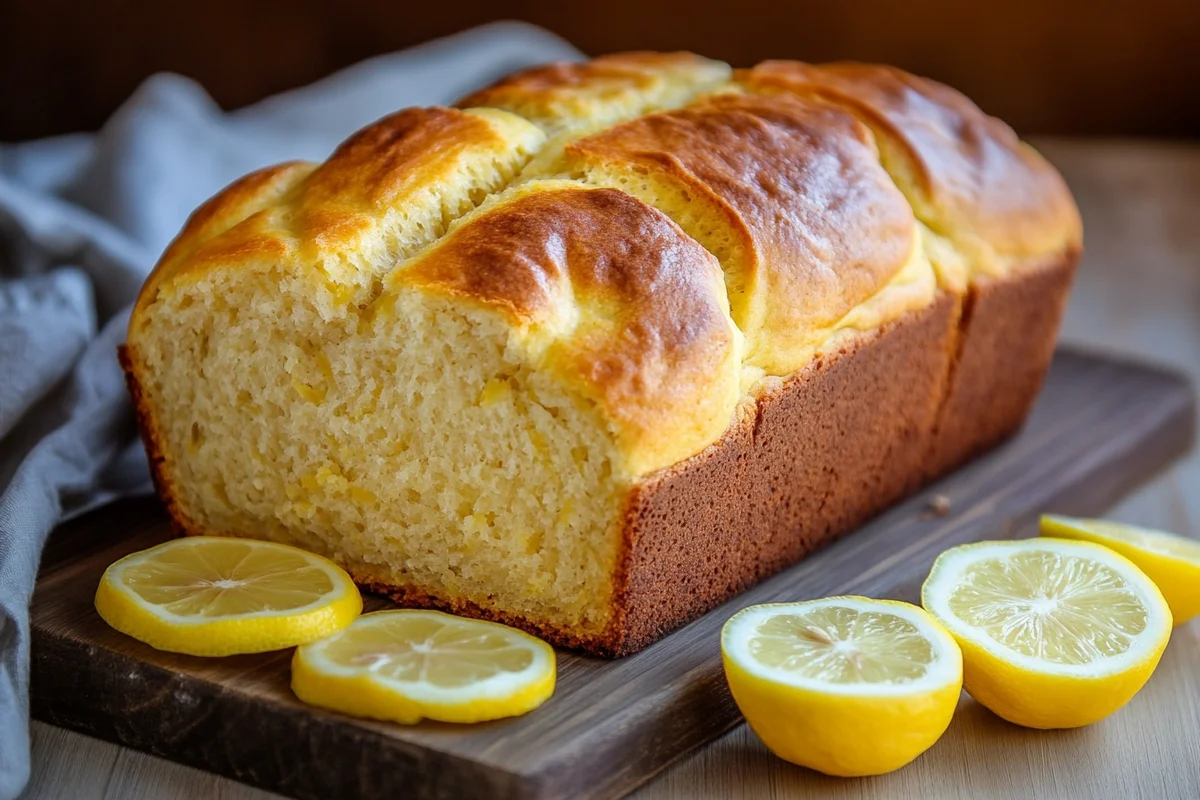Introduction
Lemon bread is a delightful baked treat cherished for its sunny taste and moist texture. Many people wonder: What is lemon bread made of? The answer is quite simple, yet each ingredient plays a critical role. This fragrant loaf is not only sweet but also fresh and tangy. It’s perfect as a dessert, a mid-afternoon snack, or even a refreshing breakfast option. Today, we’ll take a close look at the essential ingredients, as well as the best methods and tips, to ensure that your lemon bread stands out.
Transition words make a big difference when reading, so let’s glide through these sections step by step. You’ll discover why each ingredient matters and learn about variations you might enjoy. By the end, you’ll have all the knowledge you need to bake a luscious loaf of lemon bread.
What Is Lemon Bread Made Of?
The keyphrase “what is lemon bread made of” drives many baking enthusiasts to search for a clear answer. Lemon bread is composed of flour, sugar, eggs, a fat source like butter or oil, leavening agents, and, of course, lemons in different forms. These parts come together to produce a bright yet sweet flavor that many people adore.
Although you might think lemon bread is complicated, the process is straightforward. Each component has a unique job, creating a soft crumb and that signature burst of citrus. Because of this balance, lemon bread has become a classic in many kitchens.
Ingredients for Lemon Bread
- Flour
Flour is the base of any bread, and lemon bread is no different. All-purpose flour is often used because it provides enough protein to form structure but still yields a tender crumb. The starch in the flour also absorbs liquid, holding the bread together as it bakes.
In some recipes, bakers might swap half of the all-purpose flour for whole wheat to add a denser texture, but the classic recipe remains all-purpose.
- Sugar
Sugar sweetens the loaf and helps balance the tart lemon flavor.
Can you reduce sugar? Yes, but reducing it significantly might change the texture and moisture level.
Sugar also aids in browning, giving the lemon bread an appealing golden crust.
- Eggs
Eggs bind the ingredients together and provide structure and moisture.
Without eggs, lemon bread might crumble or fail to rise properly.
For egg allergies, substitutes like applesauce or flaxseed « eggs » can be used, but the taste or texture might shift slightly.
- Butter or Oil
Many recipes use butter for its rich flavor, while others rely on oil (like vegetable or canola oil) for added moisture.
Butter: Richer flavor.
Oil: Even moister crumb.
Some people combine both for a balanced taste and texture.
- Leavening Agents (Baking Powder or Baking Soda)
Leavening agents create lightness and help the loaf rise.
Baking powder or baking soda reacts with the acidic lemon components, making the bread airy instead of dense.
- Lemons – Juice and Zest
Fresh lemon juice and zest are essential for a true lemony punch.
Zest contains aromatic oils, enhancing fragrance and flavor.
Omitting zest might still yield a lemon taste, but without that bright, citrusy aroma.

Components of Lemon Bread That Add Moisture
Milk, Yogurt, or Sour Cream:
Dairy items like milk, yogurt, or sour cream bring added moisture and subtle richness. Yogurt or sour cream is especially helpful if you want a moist crumb and a lightly tangy undertone. This tang works well with the lemon, enhancing the overall brightness of the loaf.
Extra Lemon Syrup or Glaze:
Some bakers brush the top of their lemon bread with a lemon syrup or lemon glaze after baking. This step adds sweetness and intensifies the lemon flavor. It also helps keep the loaf moist for days. If you enjoy a sweeter result, try drizzling a glaze made from lemon juice and powdered sugar. If you want more of a subtle flavor, skip the glaze and let the bread speak for itself.
What Goes Into Lemon Bread: Additional Flavor Boosters
Beyond the basic parts, some people enjoy throwing in extra ingredients to change up the taste or texture. Transition words like “furthermore” and “in addition” can help us jump from idea to idea. These boosters might include:
- Vanilla Extract: A small amount of vanilla extract can balance the lemon’s bite.
- Poppy Seeds: These add a slight crunch and a nutty undertone that pairs well with citrus.
- Herbs: Some adventurous cooks add fresh rosemary or thyme. These herbs complement lemon in savory dishes, so they can also add a unique twist to your bread.
- Berries: Blueberries or raspberries introduce a pop of color and extra flavor.
How Is Lemon Bread Made?
Mixing the batter for lemon bread follows a general quick bread method. First, sift or stir together your dry ingredients, like flour, sugar, and baking powder. Next, whisk your wet ingredients, such as eggs, melted butter, or oil, and lemon juice. Finally, combine both mixtures gently, folding them until there are no lumps.
It’s important to avoid overmixing. Overmixing leads to a denser texture. You want to keep the crumb light, so it’s best to stir just until the flour disappears. Then, you can pour your batter into a greased loaf pan and bake it in a preheated oven.
If you plan to add a glaze, poke a few holes in the loaf while it’s still warm. Then drizzle the glaze on top, allowing it to seep into the bread. This technique packs even more flavor and keeps things moist.

Lemon Bread Recipe Ingredients: Key Tips
It’s not enough to know the ingredients; you should also understand how they interact. Because lemon bread is a simple recipe, each ingredient matters.
- Room-Temperature Eggs:
Keeping eggs at room temperature allows them to mix more smoothly into the batter. This tip helps your loaf bake evenly, which prevents problems like sinking in the middle. - Fresh Lemons:
Using fresh lemons is vital. Bottled lemon juice might work in a pinch, but it can’t match the flavor of fresh juice. Meanwhile, the zest from fresh lemons carries aromatic oils that dried peel cannot replicate. - Correct Flour Measurement:
Measure flour accurately. Too much flour leads to a dry, heavy loaf. You can use the “spoon and level” method by fluffing the flour with a spoon, scooping it into your measuring cup, and leveling it off with a knife. - Balancing Sweetness and Tartness:
If you love a sharper citrus taste, feel free to adjust the amount of sugar. You can even increase the lemon juice slightly or add more zest. Taste is subjective, so don’t be afraid to tweak the ratio until you find your sweet spot.
What’s in Lemon Bread: Flavor Variations
Baking is a creative outlet, so experiment with new flavors that pair nicely with lemon. Some simple spins include:
- Coconut Lemon Bread: Add coconut milk and shredded coconut for a tropical twist.
- Honey Lemon Bread: Replace some sugar with honey for a floral note.
- Citrus Mix: Blend lemon with orange or lime juice to create a mixed citrus loaf.
- Cream Cheese Swirl: Dollop a sweet cream cheese mixture into the batter before baking.
Each variation changes the texture and taste slightly. Moreover, these additions let you enjoy lemon bread all year with fresh ideas and fresh flavors.
Components of Lemon Bread That Influence Texture
Lemon bread remains a soft, moist loaf when made well. But certain factors can affect the crumb’s density and moisture:
- Fat Content:
Butter yields a denser crumb but adds richness. Oil tends to keep the bread light and moist for a longer time. - Sugar Level:
Sugar doesn’t just provide sweetness. It also softens the crumb. If you cut too much sugar, the texture might become drier. - Leavening Ratio:
You must balance baking powder or baking soda with the acidic lemon juice or sour cream. Too little leaves you with a flat loaf. Too much, and you might get an uneven crumb. - Baking Temperature:
A moderate oven temperature, around 350°F (175°C), is typical for lemon bread. If the oven is too hot, the outside might brown too quickly while leaving the inside undercooked.
How to Make Lemon Bread Step by Step
To illustrate how the ingredients come together, here’s a quick walk-through:
- Prep and Preheat:
Gather all your items, and preheat your oven. Spray your loaf pan or line it with parchment paper. - Combine Dry Ingredients:
In one bowl, whisk flour, sugar, baking powder, and salt. - Combine Wet Ingredients:
In another bowl, mix eggs, melted butter (or oil), fresh lemon juice, and lemon zest. For extra moisture, add yogurt or sour cream. - Fold Gently:
Pour the wet blend into the dry mixture. Fold until just combined. This is where you can gently stir in poppy seeds, fresh berries, or other extras. - Bake:
Bake until a toothpick inserted in the center comes out clean. This might take 45-55 minutes, depending on your oven. - Glaze (Optional):
While your loaf is warm, poke holes on top and brush with a lemon-sugar syrup. If you prefer a thicker topping, whisk powdered sugar and lemon juice to make a glaze. Spread that across the top once the loaf cools.
The result is a bright, tangy loaf that smells amazing. Each slice will have a tender crumb, a subtle lemon zing, and a dash of sweetness.
Key Ingredients for Lemon Bread Storage
1. Storing at Room Temperature
Lemon bread can sit at room temperature for about three days if wrapped well. Use an airtight container or wrap it in plastic wrap to retain moisture and prevent it from drying out.
2. Storing in the Refrigerator
If you need the lemon bread to last longer, place it in the refrigerator for up to a week. To avoid soggy edges, check for condensation inside the container, as the bread’s moisture may create excess dampness.
3. Freezing for Long-Term Storage
For extended storage, freeze individual slices of lemon bread. Wrap each slice in plastic wrap and store them in a freezer-safe container or bag. This method allows you to thaw only what you need, keeping the rest fresh for later use.

FAQ (Frequently Asked Questions)
How long will a lemon loaf last?
A lemon loaf typically stays fresh on the counter for up to three days if wrapped well. You can also refrigerate it for about one week.
What pairs well with lemon loaf?
Lemon loaf pairs nicely with tea, coffee, or even fresh fruit. You can also top it with whipped cream or enjoy it plain.
What is sour bread made of?
Sour bread is usually crafted with a sourdough starter, which contains wild yeast and friendly bacteria. The tangy flavor comes from fermentation.
How many carbs are in lemon bread?
The carbs vary by recipe. On average, a slice of lemon bread can contain around 25-35 grams of carbohydrates. Check nutritional labels for exact details.
Conclusion
Lemon bread is a welcome combination of sweet and tangy flavors. Its moist crumb feels light, while its sunny aroma brightens any moment of the day. You now know what is lemon bread made of and how each component works. You also have a range of tips for storing and flavoring this loaf in a way that suits your taste.
By playing with ingredients like poppy seeds, berries, or even fresh herbs, you can create new variations. You can adapt sugar content to manage sweetness. The sky’s the limit when it comes to personalizing this friendly, citrusy treat. So gather your flour, sugar, eggs, butter or oil, and fresh lemons. Then mix, bake, and enjoy!

